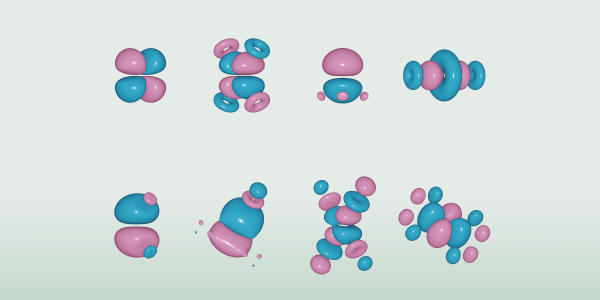Mapping the ecosystem of Wannier Functions software
By Nicola Nosengo/NCCR MARVEL
Wannier functions play an essential role in theoretical physics and computational materials science: first introduced by Swiss physicist Gregory Wannier in 1937, they allow to represent the electronic structure of a solid as a set of intuitive localized orbitals that electrons can occupy, in contrast with the “standard” quantum mechanics view that describes electrons in a solid as delocalized periodic states called Bloch states. Having a localized representation has key advantages when it comes to calculating or understanding many properties — from chemical bonding to polarization and magnetization, from conductivity to topological invariants — but for a long time there were no general solutions to this task, and so Wannier functions saw little practical applications. Thanks to the introduction of maximally-localized Wannier functions by Marzari and Vanderbilt in 1997, and the algorithms and codes to calculate these in actual materials, they are nowadays a much used tool for computational condensed matter physics and materials science.
A key decision was made earlier on of establishing a well defined protocol of communication to allow any electronic-structure code, open-source or proprietary, and independently of its internal architecture and basis set, to handshake with code(s) that calculated Wannier functions. This has led, over the years, to a rich ecosystem of codes that calculate Wannier functions or that calculate materials properties using Wannier functions. The landscape has grown so vast – thanks to both theoretical advancements and these concerted developments of accessible and efficient software – that a newcomer to the field would greatly benefit from a map to navigate it. A new review article, just published in Reviews of Modern Physics and highlighted on the journal cover, finally provides precisely that. The list of the ten authors, from all over Europe and the USA, includes three current MARVEL members (Nicola Marzari, Giovanni Pizzi and Junfeng Qiao) and three former ones (Antimo Marrazzo, Stepan Tsirkin and Sophie Beck).

Real-space depictions of maximally localized Wannier functions of a hafnium-diselinide monolayer. [Antimo Marrazzo et al. Rev. Mod. Phys. 96, 045008 (2024)]
After providing readers with the theoretical foundations on Wannier functions and their calculation, together with intuitive graphical schematics to explain what Wannier functions are, the authors map the existing Wannier codes by grouping them into three major categories: Wannier engines, that are used to obtain Wannier functions in the first place; interface codes that allow Wannier engines and first-principles tools such as DFT or GW codes to work together; and Wannier-enabled codes, that use Wannier functions as the main ingredient to accelerate accurate simulations. “As a useful byproduct of the review paper, a new online Wannier ecosystem registry has been launched and is available at https://wannier-developers.github.io/wannier-ecosystem-registry. This registry lists the codes in the ecosystem and it can be dynamically updated as more codes appear.” says Giovanni Pizzi, last author of the review.
The article describes the key applications of the codes in the Wannier ecosystem that span a wide area of computational materials science and condensed-matter physics – including band interpolation and large-scale simulations, electronic transport, Berry-phase properties, topology, electron-phonon couplings, dynamical mean-field theory, embedding, and Koopmans functionals. The authors also describe automation workflows that combine multiple software packages to take care of all the steps from the initial first-principles calculations to the Wannier-engine executions to the post-processing steps, while parsing the outputs and generating new inputs.
Overall, “several codes that now make up the Wannier ecosystem (including Wannier90, WannierBerri, WannierTools) were developed within or with the support of MARVEL, including the organization or support for workshops during which the software was developed” says MARVEL director Prof. Nicola Marzari, co-author of the review.
Antimo Marrazzo, assistant professor at SISSA (Italy) and first author of the review remarks that “putting together this review has been a formidable task that started thanks to a two-week workshop and school about Wannier-function methods we organized in 2022 at ICTP in Trieste, Italy, also with the support of MARVEL. It took us two and half years to wrap up this comprehensive work (56 pages, with several hundreds of references), but we really needed an accessible and updated map to help young researchers navigate this wide ecosystem of theories, computational methods and software implementations.”
The article concludes with a look at the future of the field and underscores the need to maintain enough “biodiversity” in the Wannier ecosystem: the coexistence of multiple software packages with partially overlapping functionalities, the authors write, helps increase robustness and allows for the cross-verification of codes. For this, “it is crucial to support the individual developers who contribute to the Wannier ecosystem and to establish structural mechanisms that ensure they receive proper scientific recognition for their work”, says Giovanni Pizzi.
Reference
A. Marrazzo, S. Beck, E. Margine, N. Marzari, A. Mostofi, J. Qiao, I. Souza, S. Tsirkin, J.R. Yates, G. Pizzi, "Wannier-function software ecosystem for materials simulations", Reviews of Modern Physics, 96 (2024). https://doi.org/10.1103/RevModPhys.96.045008
Low-volume newsletters, targeted to the scientific and industrial communities.
Subscribe to our newsletter